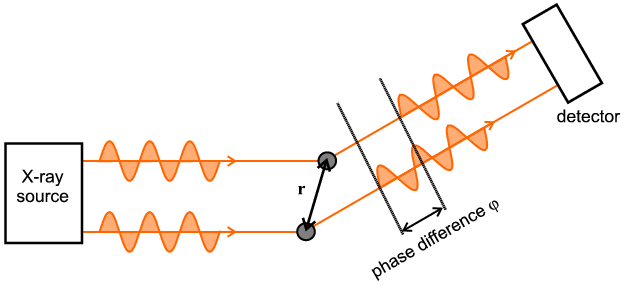 |
Scattering of X-rays by Two Electrons |
 Course Material Index
Course Material Index
 Section Index
Section Index
 Previous Page
Previous Page
 Next Page
Next Page
Scattering of X-rays by Two Electrons
We now consider what happens when, in general, two X-ray photons leave a
distant X-ray source at the same moment, are each scattered by an electron, and
then meet at a distant X-ray detector. The situation is summarised, again in
simplistic terms, by the following schematic diagram.
 Even if two X-rays start off in phase (i.e. at the same time as drawn) the
upper X-ray photon will reach the detector before the lower X-ray photon since
it has less distance to travel. We would say that the two X-ray photons are out
of phase by the time they reach the detector. The phase difference is indicated
in the diagram in terms of a length. It is more usual to express this phase
difference in terms of an angle (degrees or radians) whereby one angular
revolution (i.e. 360 degrees or 2π radians) corresponds to a phase
difference of one wavelength; e.g. in the above diagram as drawn, the two waves
end up being about one and a quarter wavelengths apart so we would say in this
case that the phase difference is λ/4 in distance, or 90 degrees or
π/2 radians, since the whole wavelength part on its own would have no
net effect whereas the additional quarter does matter. What the "detector then
sees" depends critically on the precise value of this phase difference: If the
phase difference is a whole number of wavelengths in distance (or
2 n π radians, where n = an integer)
then constructive interference occurs; if the phase difference is half a
wavelength in distance then destructive interference occurs; all intervening
cases are also possible - if you are not familiar with the idea of constructive
and destructive interference then click
here for an explanative diagram.
Even if two X-rays start off in phase (i.e. at the same time as drawn) the
upper X-ray photon will reach the detector before the lower X-ray photon since
it has less distance to travel. We would say that the two X-ray photons are out
of phase by the time they reach the detector. The phase difference is indicated
in the diagram in terms of a length. It is more usual to express this phase
difference in terms of an angle (degrees or radians) whereby one angular
revolution (i.e. 360 degrees or 2π radians) corresponds to a phase
difference of one wavelength; e.g. in the above diagram as drawn, the two waves
end up being about one and a quarter wavelengths apart so we would say in this
case that the phase difference is λ/4 in distance, or 90 degrees or
π/2 radians, since the whole wavelength part on its own would have no
net effect whereas the additional quarter does matter. What the "detector then
sees" depends critically on the precise value of this phase difference: If the
phase difference is a whole number of wavelengths in distance (or
2 n π radians, where n = an integer)
then constructive interference occurs; if the phase difference is half a
wavelength in distance then destructive interference occurs; all intervening
cases are also possible - if you are not familiar with the idea of constructive
and destructive interference then click
here for an explanative diagram.
The mathematical equation that summarises the whole situation above will not be
obvious to non-mathematical students since it uses both vector algebra and
complex numbers. Even if you cannot understand the mathematical details, it is
still beneficial to follow the argument in a qualitative way: It can be shown
by the use of vector scalar products that the phase difference in the above
figure is 2πS.r (in radians) where r is the (vector)
separation between the two electrons responsible for the double scattering.
Next, this difference is translated into a wave relationship by the use of
either a sine or cosine function, but as a final mathematical twist the complex
number form of Demoivre's theorem is normally used to represent a cosine (the
real part) or sine (the imaginary part) function. The final result is expressed
as:
F(S) = e2π i
S.r
where F signifies the amount of scattering (which is a function of both
wavelength and angle 2θ in that S equals
2 sinθ / λ) arising from the phase difference
between the upper and lower scattered waves.
 Course Material Index
Course Material Index
 Section Index
Section Index
 Previous Page
Previous Page
 Next Page
Next Page


